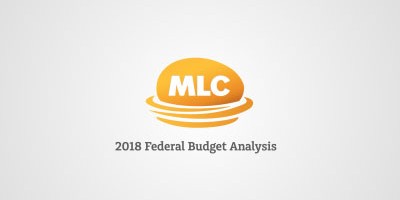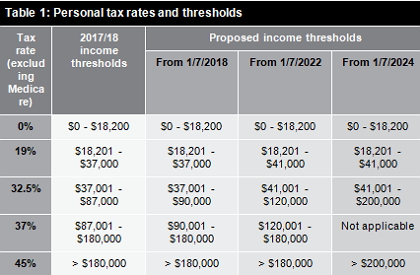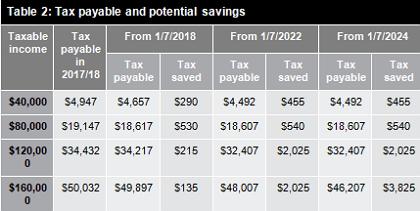2018 Federal Budget Analysis
May 9, 2018
Summary of Budget measures
Note: These changes are proposals only and may or may not be made law.
From 1 July 2018
-
Low and middle income earners are to benefit from tax savings of up to $530 per person (or $1,060 per couple).
-
The Medicare Levy will remain at 2%.
-
The $20,000 instant asset write-off for business with aggregate turnover less than $10m will be extended
until 30 June 2019.
-
Funding for home care services and residential aged care will increase.
From 1 July 2019
-
A one year exemption from the ‘work test’ will apply to recent retirees who have less than $300,000 in total super savings.
-
Life insurance can only be offered in super on an ‘opt-in basis’ to new members under 25 years of age or members with inactive accounts or an account balance under $6,000.
-
Fees when exiting a super fund will be banned and administration/investment fees will be capped at 3% pa on accounts with balances of less than $6,000.
-
The ATO will work to proactively reunite Australians’ dormant superannuation funds with their active account, with inactive balances less than $6,000 to be transferred to the ATO.
-
The Pension Loans Scheme will be available to all Australians over Age Pension age and the maximum payments will increase to 150% of the full Age Pension.
Opportunities post 1 July 2018
There are some key opportunities announced in previous Federal Budgets that are already legislated to take effect on
1 July 2018. These include:
-
People aged 65 or over can make ‘downsizer’ super contributions of up to $300,000 from the proceeds of selling
their home.
-
First home buyers who have made super contributions under the First Home Super Saver Scheme can access their
money for eligible property purchases.
-
Where the annual concessional contribution cap is not fully utilised, it may be possible to accrue unused amounts
for use in subsequent financial years.
Further information on these opportunities can found at the end of this summary.
Taxation
Personal income tax savings
Date of effect: From 1 July 2018
Low and middle income earners will benefit from tax savings of up to $530 per person (or $1,060 per couple), via a series
of changes to be implemented over seven years.
Personal income tax thresholds
The income threshold at which the 32.5% marginal tax rate applies will progressively increase to $200,000 by 1 July 2024.

Personal tax offsets
-
A Low and Middle Income Earners Tax Offset of up to $530 will apply from 1 July 2018 to 30 June 2022.
-
From 1 July 2022, the Low Income Tax Offset will increase from $445 to $645.
Personal tax savings
Table 2 below illustrates the tax payable in future financial years (and the potential tax savings compared to 2017/18) for a range of taxable incomes. These figures take into account the proposed personal income threshold and tax offset changes.

Medicare levy to stay at 2%
The previously proposed increase in the Medicare levy to 2.5% from 1 July 2019 has been abandoned.
Extension of instant asset write off
Date of effect: From 1 July 2018
Small businesses with turnover of less than $10 million will be able to immediately write-off newly acquired eligible
assets valued at less than $20,000 for a further 12 months.
Superannuation
Work test exemption for retirees
Date of effect: 1 July 2019
A person aged 65 to 74 is currently able to make contributions to superannuation if the ‘work test’ has been satisfied
(ie they have worked at least 40 hours in 30 consecutive days) in the financial year the contribution is made.
A one year exemption from the work test will apply to older Australians who have less than $300,000 in total super
savings. This exemption will apply to the financial year following the last year the work test was satisfied. This will
allow an additional period of time for those eligible to contribute to superannuation.
Insurance in super
Date of effect: 1 July 2019
In many super funds, including MySuper and employer funds, insurance is offered as a default option. It’s proposed
that members will need to ‘opt-in’ for insurance where they:
-
have a balance less than $6,000
-
are new members under age 25, or
-
have an account which has not received a contribution in 13 months and are considered inactive.
Protection for small super balances
Date of effect: 1 July 2019
Measures will be introduced to reduce the impact of fees on low super balances and focus on returning lost
super to members.
-
Protection will be provided to super accounts by limiting administration and investment fees to a 3%
annual cap. This cap will apply to accounts with balances below $6,000.
-
Exit fees will also be banned on all super accounts.
-
A $6,000 threshold will apply to inactive accounts. These accounts will need to be transferred to the ATO.
The ATO will increase data matching activities to return amounts to active accounts held by members.
Personal deductions
Date of effect: 1 July 2018
The ATO will develop new compliance processes for taxpayers claiming a deduction for personal superannuation
contributions. This includes raising awareness regarding the necessary steps, including lodging a ‘notice of intent
to claim a tax deduction’ form with the super fund trustee.
Inadvertent concessional cap breaches
Date of effect: 1 July 2018
Employers are required to pay Superannuation Guarantee (SG) based on an individual employee’s income.
For some individuals this means their concessional contribution cap is breached by the total of multiple employers’
compulsory contributions.
Individuals who have a total income exceeding $263,157 pa and multiple employers will have the option to elect
to no longer have SG contributions paid on certain income from their employer. This overcomes the inadvertent
breach of the concessional contribution cap and associated tax penalties.
SMSF increase in member numbers
Date of effect: 1 July 2019
Self-managed superannuation funds (SMSFs) are limited to having four members. This threshold will increase
to six to provide greater flexibility and allow families, for example, to all be members of the same SMSF.
SMSF three-year audit cycle
Date of effect: 1 July 2019
SMSFs with a history of good record-keeping and compliance will move from providing an audit on an annual basis
to a three-yearly cycle. Eligible SMSFs will be those with a history of three consecutive years of clear audit reports
and have lodged annual returns on time.
Social security
Pension Loans Scheme
Date of effect: 1 July 2019
The Pension Loans Scheme allows eligible individuals to access some of the equity in the home or other property
via a Government loan, which is advanced in fortnightly instalments.
This scheme will be available to all Australians over Age Pension age and the maximum loan payments will increase
to 150% of the full Age Pension. Eligibility will continue to limited by the value of the property used as loan security.
The following table summarises the payment ranges for singles and couples based on current rates, where the full
pension and no pension is available.

Work Bonus
Date of effect: 1 July 2019
Under the Work Bonus, the first $300 per fortnight (currently $250) of employment income will not count when calculating
Age Pension entitlements under the income test.
Self-employed retirees will be able to access the scheme for the first time.
A ‘personal exertion test’ will ensure the bonus only applies to income earned from paid work.
Any unused Work Bonus (up to a total of $7,800 pa) can continue to be accrued to reduce assessable employment income
in a future period.
Means-testing of certain lifetime income streams
Date of effect: 1 July 2019
Favourable social security rules will be introduced to encourage the development and use of income products that
will help retirees reduce the risk of outliving their savings.
Under the proposed rules, only 60% of the amount initially invested in these ‘lifetime income streams’ will be assessed
under the assets test. This concession will apply until the account holder is 84 (or for a minimum of five years). After this
time, only 30% will be assessed for the rest of the person’s life. Also, only 60% of the income payments will be assessed
under the income test.
Means testing of Carers Allowance
Date of effect: To be confirmed by Government
As previously announced, the Carer Allowance and Carer Allowance (child) Health Care Card will be income tested. Households earning over $250,000 won’t be eligible. Both existing and new recipients of Carer Allowance will need
to meet this income test.
Aged care
Additional funding for aged care
Date of effect: From 1 July 2018
Funding for home care services and residential aged care will increase, including:
-
14,000 new home care packages over four years
-
13,500 new residential aged care places, and
-
grants for aged care facilities in rural, regional and remote areas.
Legislated super changes post 1 July 2018
Downsizer contributions
Individuals aged 65 or older may be able to make super contributions of up to $300,000 (or $600,000 per couple)
from 1 July 2018 when selling their home.
These contributions, known as ‘downsizer contributions’ can be made without having to meet a ‘work test’ or ‘total super balance test’ and they don’t count towards the contribution caps. However, they must be made with 90 days of settlement
and a tax deduction can’t be claimed.
The property must have been owned for at least 10 years and have been the main residence at some time during this period.
First home super saver scheme – access
First home buyers who have made super contributions under the First Home Super Saver Scheme (FHSSS) can access
their money from 1 July 2018.
The FHSSS started on 1 July 2017 and allows eligible first home buyers to save a deposit in the concessionally taxed superannuation system. Contributions of up to $15,000 per year (and a total of $30,000) can be made and they count
towards the relevant contribution cap.
An online estimator is available to explore the potential benefits of using the FHSSS.
Catch-up concessional contributions
Where the annual concessional contribution (CC) cap is not fully utilised from 1 July 2018, it may be possible to accrue
unused amounts for use in subsequent financial years.
The CC cap is currently $25,000 pa1. Counted towards this limit are all employer contributions (including super guarantee
and salary sacrifice), personal tax deductible contributions and certain other amounts.
Unused cap amounts can be accrued for up to five financial years. 2019/20 is the first financial year it will be possible
to use carried forward amounts.
To be eligible, individuals cannot have a total super balance exceeding $500,000 on the previous 30 June.
This measure could help those with broken work patterns and competing financial commitments to better utilise the CC
cap. It could also help to manage tax and get more money into super when selling assets that result in a capital gain.
-
This cap applies in FY 2017/18 and 2018/19. It may be indexed in future financial years.
Important information
The Federal Budget Analysis prepared by the MLC Technical team, part of GWM Adviser Services Limited, appears below.
The information contained in this Federal Budget Analysis is current as at 8 May 2018 and is prepared by MLC Technical, part of GWM Adviser Services Limited ABN 96 002 071749, registered office 150-153 Miller Street North Sydney NSW 2060, a member of the National Australia Bank Group of Companies.
Any advice in this Federal Budget Analysis has been prepared without taking account of your objectives, financial situation or needs. Because of this you should, before acting on any advice, consider whether it is appropriate to your objectives, financial situation and needs. Any tax estimates provided in this publication are intended as a guide only and are based on our general understanding of taxation laws. They are not intended to be a substitute for specialised taxation advice or a complete assessment of your liabilities, obligations or claim entitlements that arise, or could arise, under taxation law, and we recommend you consult with a registered tax agent.
Past performance is not a reliable indicator of future performance.
Before acquiring a financial product, you should obtain a Product Disclosure Statement (PDS) relating to that product and consider the contents of the PDS before making a decision about whether to acquire the product.
MLC companies are subsidiaries of National Australia Bank Limited ABN 12 0004 044 937. An investment with MLC is not a deposit or liability of, and is not guaranteed by, National Australia Bank Limited.
Powered by WPeMatico
